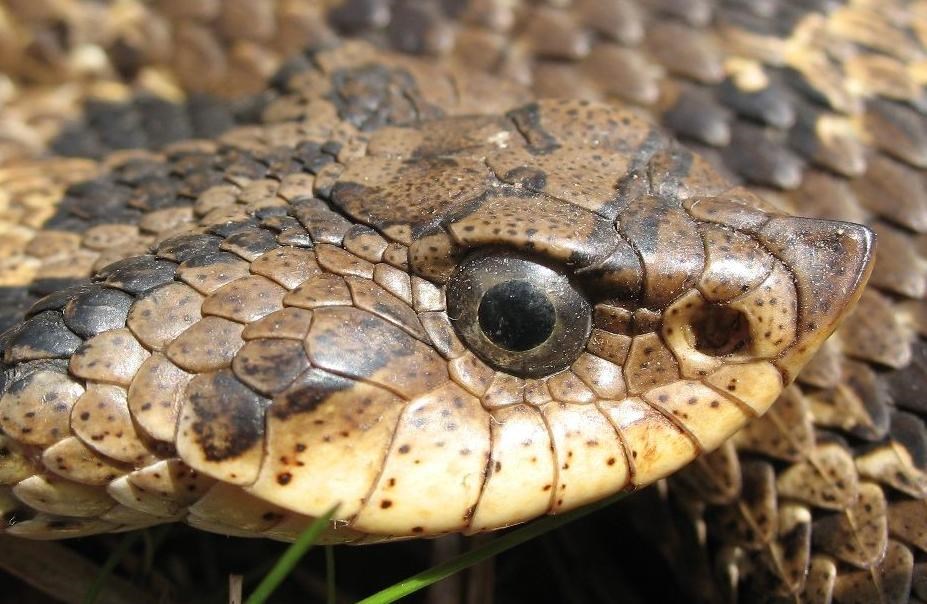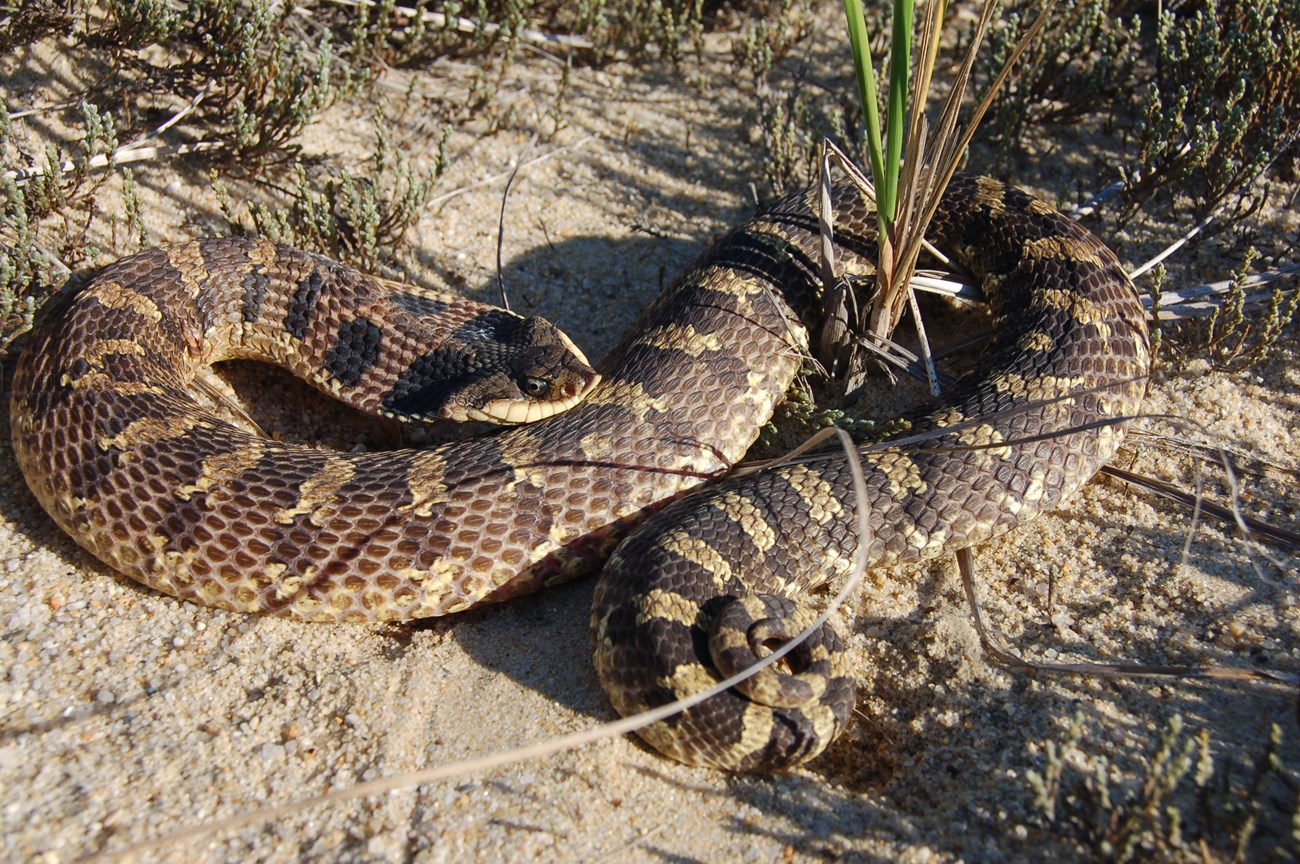
Scott Buchanan The EASTERN HOG-NOSED SNAKE is the ultimate Cape Cod snake, a species specialized for the sandy habitats that typify the national seashore. It uses its upturned snout to burrow into the sand, where it hides or searches for its primary food, Fowler's and spadefoot toads. Although toads produce toxins to protect themselves from predators, hog-nosed snakes evolved a tolerance to these toxins and became a specialized predator. Highlighting this predatory specialization, and the strategy/counter-strategy often seen in evolution is a pair of enlarged teeth in the rear of the hog-nosed snake's mouth. A common defense of toads is to inflate themselves, to appear larger and prevent themselves from being swallowed. Hog-nosed snakes use their rear teeth to counter the inflated toad, by puncturing and deflating them. Unlike the black racer, which uses its speed to escape danger, the Eastern hog-nosed snake is stocky and slow moving. Lacking speed, it reacts to potential predators by performing a multi-act defensive display. First, it hisses loudly and uses a series of bluffs, flattening out its head and neck into a "hood," similar to a cobra, to appear large and ferocious. It may twist and turn, and strike, without actually opening its mouth or biting. 
R. Cook If acting tough does not work, it rolls over and plays dead, going limp, with mouth agape and tongue hanging out, sometimes regurgitating its last meal. This death-feigning strategy, coupled with foul-smelling secretions from musk glands aims to convince the predator it is too dead to be palatable. Hog-nosed snakes are so persistent in feigning death that if you place them right side up, they will roll back over and continue to 'play' dead. Many hog-nosed snakes have been killed because people are often unfamiliar with these harmless behaviors. 
Lisa Sette Hog-nosed snakes were once wide-spread and abundant along the sandy beaches and coastal plain of the Northeast, including many beaches that are now heavily urbanized, such as Coney Island in Brooklyn. Unfortunately, many hog-nosed snake populations in our region are now long gone, due to habitat loss and fragmentation, road kill, and human persecution, partly based on a lack of understanding their unique behavior. It is now rare in the Northeast to find a place where hog-nosed snakes remain common. Fortunately, Cape Cod National Seashore is such a place. Observations of hog-nosed snakes by seashore staff and visitors, primarily in the Province Lands, indicate that hog-nosed snakes remain fairly common here. This is also true for many of the 100 or so other regionally declining animal species that occur here, such as box turtles, spadefoot toads, ribbon snakes, piping plover, roseate terns, and whip-poor-wills, and it highlights the important role that Cape Cod National Seashore plays in supporting native species biodiversity. Human impacts have eliminated populations of many sensitive species from our region's landscape. For many of these species, protected natural areas like Cape Cod National Seashore represent some of the last, best remaining opportunities for preserving these species as part of our regional wildlife community. In addition to preserving regional species diversity, the abundance of certain species at Cape Cod National Seashore provides unique opportunities to study regionally rare species that are now too scarce in other places. In the case of the Eastern hog-nosed snake, thesis research conducted by graduate student Scott Buchanan using radio-telemetry has provided insight into life history, activity, and movements that had largely been undocumented in the Northeast. For example, Buchanan's research documented the first ever case of a hog-nosed snake returning to the same underground burrow, or "hibernaculum," it used the previous winter 1. Similarly, by tracking movements and behavior, and recording their weights over the course of the summer, it was found that 7 of 8 females laid eggs, with four individuals that were tracked for two years laying eggs in both years. Such a high proportion of females laying eggs, particularly in consecutive years, does not occur in most populations of this species and suggests that the seashore's population is well fed2. Buchanan's research also showed that although hog-nosed snake activity typically occurs in the daytime, they spend most of their time hiding in vegetation or underground. When they were "out and about," it was mostly from 2 to 7 hours after sunrise. During these active periods, snakes were roughly 5 to 7 °C warmer than the air temperature, and the moderate summer temperatures of the seashore often provide optimal thermal conditions for carrying out life functions such as movement, digestion, and egg production inside the female. Females were slightly more active than males, except in September when this reverses, as males search for females with which to mate.3 Both sexes frequently moved, averaging 34 meters/day Females about to lay eggs moved less, but made up for this with much greater movement after egg laying. On average, seashore hog-nosed snakes have a home range of 35.4 hectares (87.5 acres), which is smaller than in other populations. High toad densities in the wetland-rich Province Lands may be the cause. Although common in the Province Lands, with its abundance of open sandy habitat, hog-nosed snakes preferred vegetated edges and avoided open sandy areas. This preference may seem counter to our perceptions or expectations, but in reality, they are more vulnerable to predators in open patches.4 In spite of their incredible anti-predator behaviors, it is still in the snake's best interest to avoid predators whenever possible. The hog-nosed snake is a perfect indicator species for natural landscape integrity on Cape Cod. It is sensitive to habitat loss, development, and fragmentation, and feeds exclusively on wetland-dependent prey, Fowler's and spadefoot toads. Thus it requires a relatively large and undeveloped landscape with an abundance of both upland and wetland habitats. Cape Cod National Seashore seems to provide such a landscape, and the seashore's population of hog-nosed snakes appears to be well protected here, in spite of the small numbers killed on roads each year. Certainly, the research conducted here is consistent with this notion. The relative abundance of hog-nosed snakes here is important in and of itself, but it is also important for providing park visitors a chance to encounter one of our region's true coastal specialists, a once common species that has disappeared from so many places, as well as from our collective consciousness. What makes national parks so special is that they exist to preserve nature and history as it was, and provide visitors with an opportunity to learn about and experience it first-hand. In the case of Cape Cod National Seashore, its creators sought to preserve "its scenery, its historical associations, its reminders of an older and quieter way of life than most of us now enjoy, its wildlife and its flora…"5 Thus, when encountering a hog-nosed snake or any of the other rare species still found here, it is like taking a trip back in time, back to when these species were widespread, abundant, and familiar across the landscape. An experience that is becoming increasingly rare in our region, Cape Cod National Seashore is one of the best remaining places to have it. With your help and cooperation, we can preserve it for future generations. 1 Buchanan, S.B., B.C.Timm, R.P. Cook, and R. Couse. 2012. Heterodon platirhinos (Eastern Hog-nosed Snake). Hibernacula site fidelity. Herpetological Review 43(3):493-494. 2 Buchanan, S.B., B.C.Timm, R.P. Cook, and R. Couse. 2013 Heterodon platirhinos (Eastern Hog-nosed Snake). Reproduction –Oviposition Frequency. Herpetological Review 44(4):691-692. 3 Buchanan, S.B., B.C.Timm, R.P. Cook, and R. Couse, and L.C. Hazard. 2016. Surface Activity and Body Temperature of Eastern Hognose Snakes (Heterodon platirhinos) at Cape Cod National Seashore, Barnstable County, Massachusetts, USA. J. Herpetology, 50(1):17-25. 4 Buchanan, S.B., B.C.Timm, R.P. Cook, and R. Couse. in review. Spatial ecology and habitat selection of Eastern Hognose Snakes (Heterodon platirhinos) at Cape Cod National Seashore, Massachusetts, USA. Journal of Wildlife Management. 5 H.R. Rep No 673, 87th Cong., 1st Sess., reprinted in [1961] IV House Miscellaneous Reports on Public Bills 18. |
Last updated: January 30, 2018
